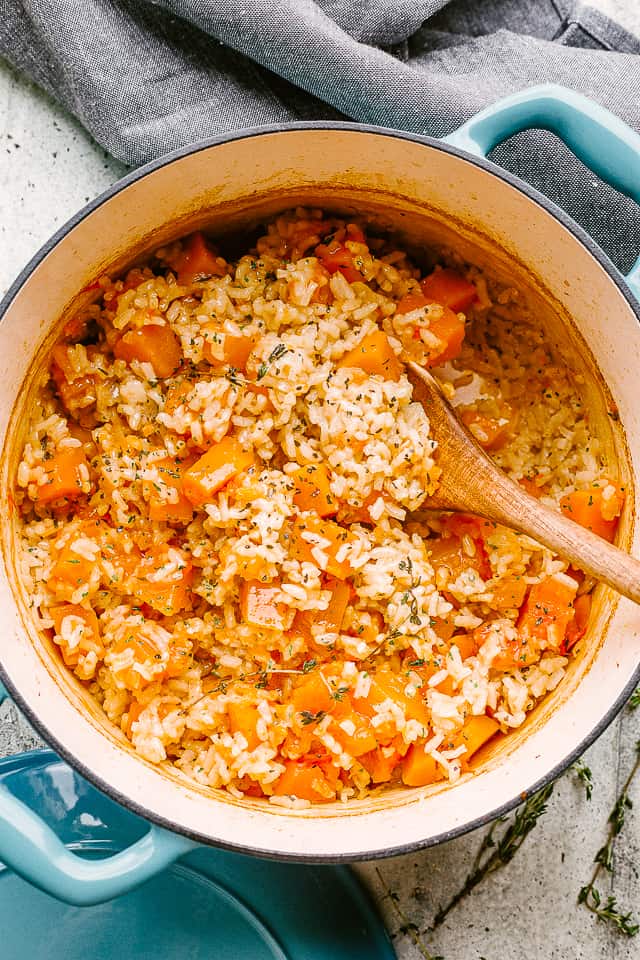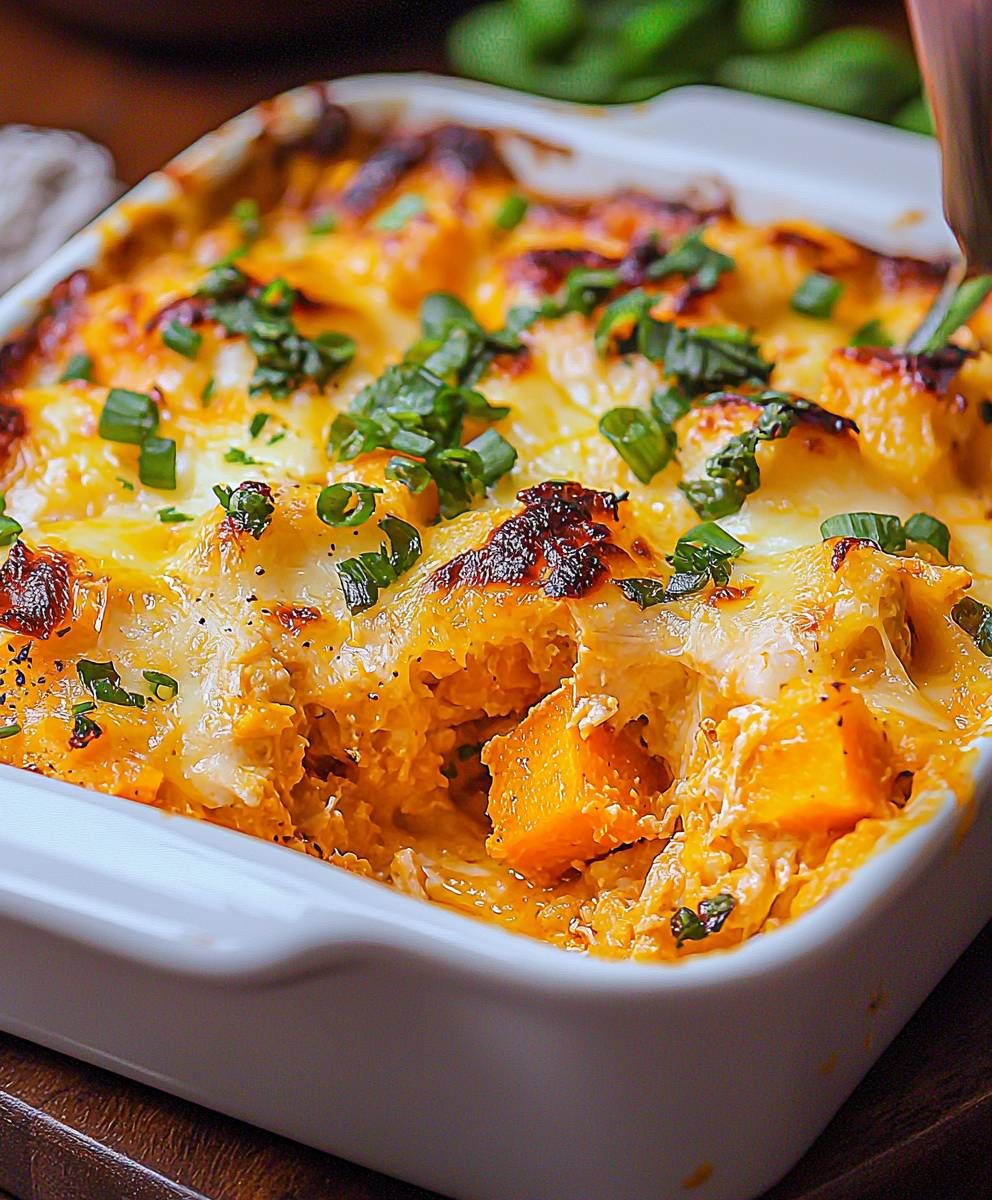
Butternut Squash Casserole is a comforting and flavorful dish that brings warmth to any table. Made with tender roasted or mashed butternut squash, this casserole blends natural sweetness with savory spices, creamy textures, and often a crunchy topping of breadcrumbs or pecans.
It’s a versatile recipe that can be served as a hearty side dish during the fall and winter months, especially around holidays like Thanksgiving.
Whether paired with roasted meats or enjoyed on its own, this casserole is both nourishing and satisfying. Its rich, golden color and aroma make it a cozy favorite for family dinners and gatherings.
Warm, comforting, and packed with the natural sweetness of roasted butternut squash, this casserole is the perfect side dish for fall dinners, holiday meals, or even a cozy weeknight. Topped with a buttery crumble or savory cheese layer, it strikes a balance between sweet and savory — and is always a crowd-pleaser.
Butternut Squash Casserole: An Incredible Ultimate Recipe for Everyone
Description
Butternut Squash Casserole is a comforting, wholesome dish that blends the natural sweetness of roasted butternut squash with savory herbs, creamy textures, and a crunchy topping.
Often enriched with ingredients like cheese, breadcrumbs, or nuts, this casserole is a perfect side or vegetarian main for fall and winter meals.
Its rich flavor and vibrant color make it a standout at holiday tables, especially Thanksgiving.
The dish is easy to prepare ahead and reheat, making it convenient for gatherings. Warm, hearty, and satisfying, it celebrates seasonal produce in a deliciously cozy way the whole family will enjoy.
Ingredients
Sweet Crumble Topping:
Instructions
-
Prepare and roast the butternut squash
Preheat your oven to 400°F (200°C). Line a baking sheet with parchment paper. Spread the cubed butternut squash on the tray, drizzle with olive oil, and season lightly with salt and pepper. Roast for 25–30 minutes, or until the squash is tender and lightly caramelized, tossing once halfway through. Remove from oven and let it cool for a few minutes. -
Sauté the aromatics
While the squash is roasting, melt 2 tablespoons of butter in a skillet over medium heat. Add the chopped onion and cook until softened, about 5–7 minutes. Stir in the garlic and cook for another 30 seconds until fragrant. Set aside to cool slightly. -
Blend the squash mixture
Transfer the roasted squash and sautéed onion-garlic mixture into a large bowl or food processor. Blend or mash until smooth (you can leave it slightly chunky for texture if preferred). Add the eggs, milk, cinnamon, nutmeg (if using), maple syrup or honey (if using), and Parmesan cheese. Mix or pulse until creamy and fully incorporated. Taste and adjust seasoning with more salt or pepper if needed. -
Assemble the casserole
Grease a 9x9-inch (or similar-sized) baking dish. Pour the squash mixture into the dish and smooth the top with a spatula.
-
Prepare your topping
Choose your desired topping (sweet or savory):
-
For the sweet crumble, combine chopped nuts, flour, brown sugar, softened butter, and cinnamon in a bowl. Mix until it resembles coarse crumbs. Sprinkle evenly over the casserole.
-
For the savory topping, mix shredded mozzarella, Parmesan, and breadcrumbs (if using), then sprinkle over the casserole.
-
-
Bake
Reduce oven temperature to 375°F (190°C). Bake the casserole for 25–30 minutes, or until the top is golden and the edges are bubbling slightly.
For extra browning, broil for 1–2 minutes at the end, watching closely to avoid burning.
-
Serve
Let the casserole cool for 5–10 minutes before serving. Garnish with fresh herbs like thyme or parsley, if desired.
Nutrition Facts
Servings 6
- Amount Per Serving
- Calories 220kcal
- % Daily Value *
- Total Fat 11g17%
- Saturated Fat 5g25%
- Cholesterol 35mg12%
- Sodium 400mg17%
- Total Carbohydrate 35g12%
- Dietary Fiber 5g20%
- Sugars 12g
- Protein 6g12%
* Percent Daily Values are based on a 2,000 calorie diet. Your daily value may be higher or lower depending on your calorie needs.
Note
Butternut squash casserole is a comforting, flavorful, and versatile dish perfect for holiday dinners, potlucks, or even a cozy family meal. Its naturally sweet and nutty flavor pairs beautifully with both savory and sweet ingredients.
Whether you’re making it as a side dish or a vegetarian main, these tips and tricks will help you achieve a rich, satisfying result.
Cooking Tips for the Perfect Butternut Squash Casserole
1. Choose the Right Squash
Pick a firm, heavy butternut squash with smooth, beige skin. Avoid squash with green patches or soft spots. A medium-sized squash (about 2–3 pounds) typically yields enough for 4–6 servings.
2. Roast for Maximum Flavor
Roasting brings out the natural sweetness of the squash and gives it a caramelized depth. Cut it into cubes, toss with olive oil, salt, and a bit of cinnamon or smoked paprika (depending on whether you're going sweet or savory), and roast at 400°F (200°C) for 25–30 minutes.
3. Blend for Creaminess
For a creamy texture, blend the roasted squash with a splash of milk or cream before adding it to the casserole. You can use an immersion blender, food processor, or even mash it by hand if you prefer a more rustic texture.
4. Use Flavor-Boosters
Add flavor layers by sautéing onions and garlic in butter or olive oil and mixing them into the squash. For a savory casserole, include thyme, rosemary, or sage. For a sweet version, try nutmeg, cinnamon, or maple syrup.
5. Cheese Is Key (Savory Version)
Adding cheese like sharp cheddar, gruyère, or parmesan gives richness and depth. Stir some into the squash mixture and sprinkle more on top for a golden crust.
6. Add a Crunchy Topping
A crispy topping adds texture contrast. Try toasted breadcrumbs, crushed crackers, or chopped pecans. For a sweet casserole, a brown sugar and oat crumble works wonderfully.
7. Don’t Overbake
Bake just until everything is heated through and the top is golden, usually 20–25 minutes at 375°F (190°C). Overbaking can dry it out.
Serving Tricks & Creative Ideas
1. Serve in Individual Ramekins
For dinner parties or holiday meals, serve the casserole in individual ramekins for a beautiful presentation and easy portioning. Guests love the personalized touch!
2. Pair with Contrasting Flavors
Butternut squash has a sweet, mellow flavor. Balance it with tangy or spicy sides—think cranberry relish, roasted Brussels sprouts with balsamic glaze, or spicy sausage.
3. Add Protein for a Main Dish
Make it a full meal by adding cooked quinoa, shredded chicken, or chickpeas. Mix it into the casserole base before baking.
4. Use as a Side for Roasted Meats
This casserole pairs beautifully with roasted turkey, pork loin, or baked ham. Its creamy, comforting nature complements bold, savory mains.
5. Garnish Before Serving
Right before serving, garnish with fresh herbs like parsley or sage for a pop of color and freshness. A drizzle of maple syrup or hot honey (for the sweet version) adds a gourmet finish.
6. Store and Reheat Smartly
Leftovers can be stored in the fridge for up to 4 days. Reheat covered in the oven at 350°F (175°C) or microwave individual portions. To maintain the crisp topping, reheat uncovered for the last few minutes.
7. Make Ahead Friendly
You can prepare the casserole up to 2 days ahead. Assemble it fully, cover tightly, and refrigerate. Bake just before serving for stress-free entertaining.
Variations
- Make it vegan: Use plant-based milk (like almond or oat), skip the eggs, and use a flax egg substitute. Use vegan butter and nutritional yeast instead of cheese.
- Add protein: Mix in cooked quinoa, lentils, or shredded chicken for a complete meal.
- Add greens: Stir in sautéed spinach or kale for extra nutrients.
- Extra creamy: Add a spoonful of sour cream or cream cheese to the squash mixture for richness.
Storage and Reheating
- Store: Refrigerate leftovers in an airtight container for up to 4 days.
- Reheat: Warm in the oven at 350°F (175°C) until heated through, or microwave individual portions for 1–2 minutes.
- Freeze: This casserole can be frozen after baking. Cool completely, wrap tightly, and freeze for up to 2 months. Thaw in the fridge overnight before reheating.
Tips for Success
- Don’t skip roasting the squash — it deepens the flavor.
- Use freshly grated cheese for the best texture and melt.
- Taste the squash mixture before baking to balance sweetness, salt, and spice.
- For a lighter version, use egg whites and low-fat milk.
Final Thoughts
Butternut squash casserole is more than just a side dish—it’s a canvas for creativity. Whether you make it sweet or savory, simple or elegant, these tips and tricks will elevate your casserole and impress your guests. It’s hearty, wholesome, and always a crowd-pleaser.
This Butternut Squash Casserole is a wholesome, cozy, and flexible dish that shines in every season — especially in fall and winter when squash is at its best.
Whether you're craving a nourishing side or a vegetarian main, this recipe offers rich flavor, texture, and comfort in every bite.
Frequently Asked Questions
Can I make Butternut Squash Casserole ahead of time?
Yes! Butternut Squash Casserole is a great make-ahead dish. You can prepare the casserole a day in advance by assembling all the ingredients and storing it (covered) in the refrigerator.
When you’re ready to bake, allow it to come to room temperature for about 30 minutes, then bake as instructed. This makes it perfect for holidays or busy weeknights.
Can I freeze Butternut Squash Casserole?
Absolutely. To freeze, prepare the casserole but don’t bake it. Wrap it tightly in plastic wrap and then foil, and store it in the freezer for up to 2–3 months. When ready to use, thaw overnight in the fridge and bake as directed. You can also freeze leftovers after baking—just ensure it’s cooled completely before storing in airtight containers.
What proteins go well with Butternut Squash Casserole?
Butternut Squash Casserole pairs wonderfully with roasted chicken, turkey, pork chops, or baked ham. It’s also great with vegetarian options like lentil loaf, grilled tofu, or chickpea patties. Its mild, slightly sweet flavor complements both savory and spiced proteins.
How can I make it healthier?
To make a lighter version, reduce or replace the butter with olive oil, use low-fat milk or dairy-free alternatives, and skip or minimize sugar if the recipe calls for it. Add in vegetables like spinach, kale, or carrots for extra nutrition, or include cooked quinoa or lentils for added fiber and protein.








